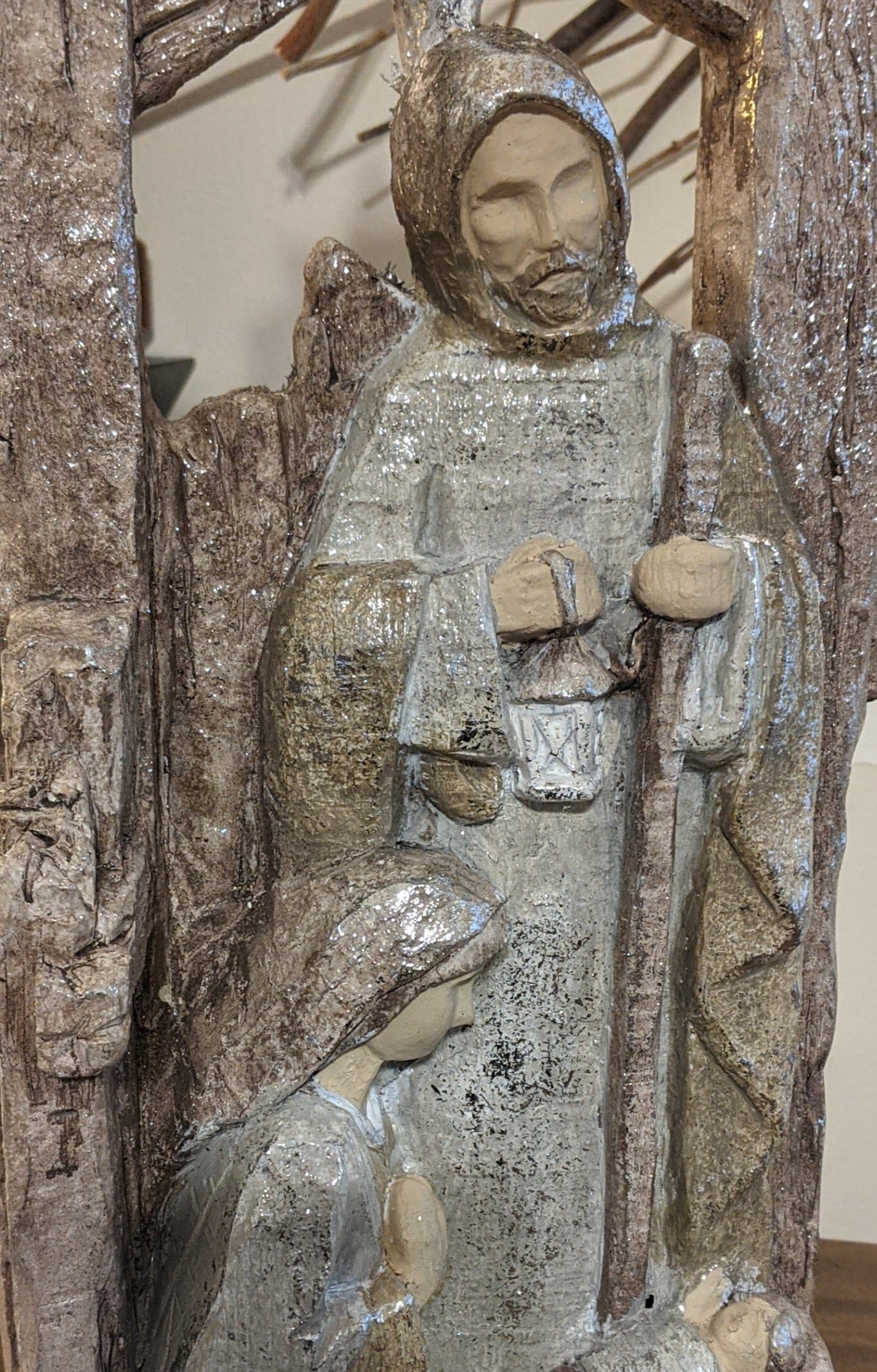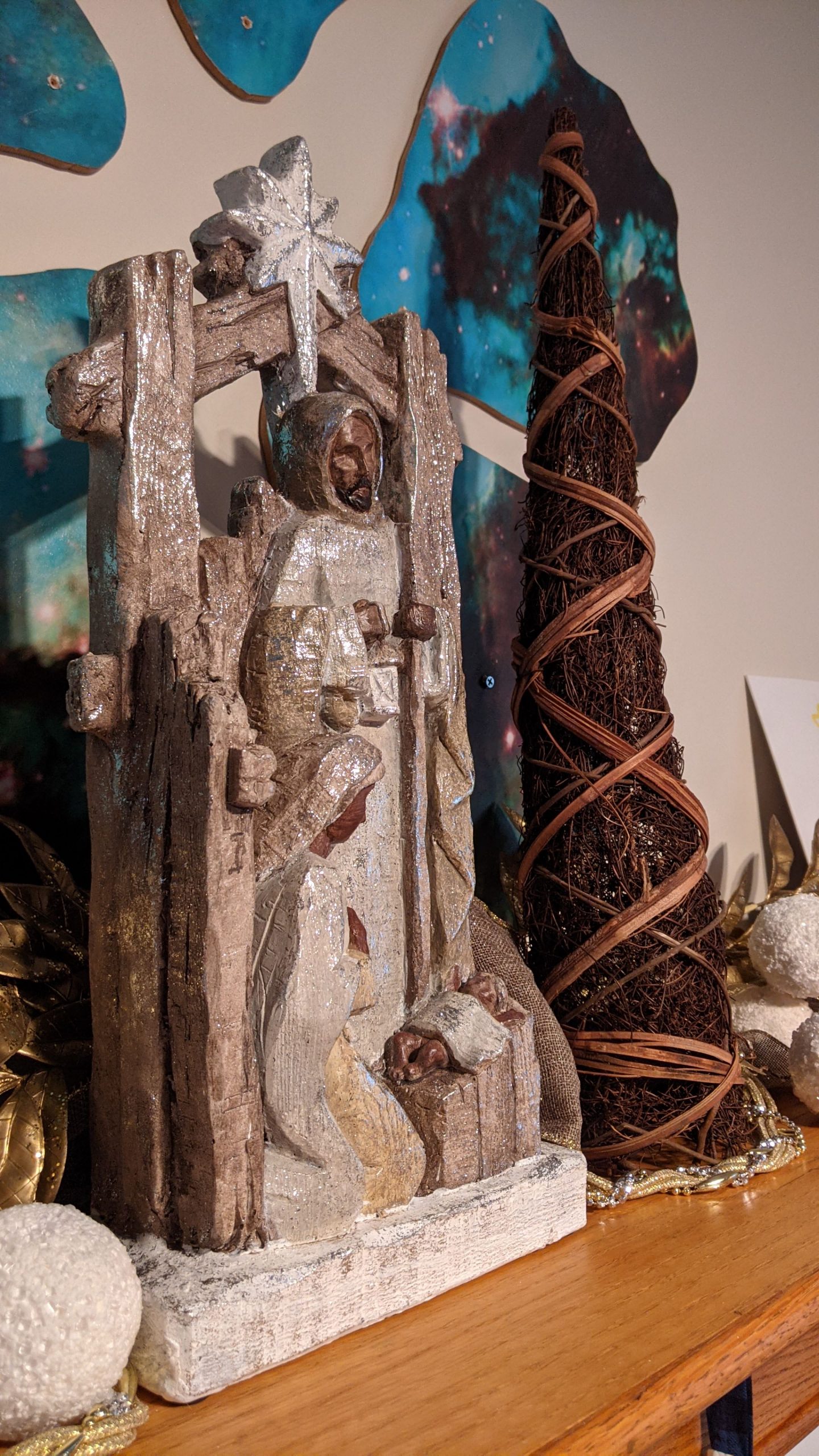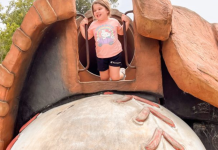

I painted the skin on my nativity set today.
Mary, Joseph, and baby Jesus are no longer white people.
Last Christmas…
As I was putting away my Christmas decor last year, it struck me that aside from a dark-skinned person here and there, all my nativity sets featured white people. Representations of the Savior’s birth in the Middle East showed white people as the majority! And isn’t that the norm in America? Of course, I’ve known for a long time that a white manger scene is historically inaccurate. But last year, it really rubbed me wrong more than ever.
A month prior, we had just brought home our second son through international adoption. I had two boys to raise, a different race than myself, and all of our representations of Jesus in our home were white — like me and their father. So far, their whole extended family is also white. Much of our community is white. And I realized, being a white mother to minority children, I had to do better.

The problem with white Jesus…
The white Jesus image permeates the American church and culture, but it simply isn’t accurate. I don’t understand why white Jesus has even come to be. It has become such a natural expectation to have a white nativity set, that I don’t think most white people even think about the implications of it.
To some, it may seem like a silly thing to get bent up over. But it matters. Diversity and race matter. And if you think it’s not a big deal, I strongly ask you to consider the message a white Jesus — and heck, a white Santa! — portrays to our children. It simply says that “white = good.” I don’t need images of Jesus to have porcelain skin in order for me to feel accepted and loved. But I do believe that defending the white Jesus image in our culture is just another way to “otherize” those with brown skin like him.
I now see how a white manger scene can be contributing to the systemic racism in our culture. It is changing the image of Christ to look like the dominant culture in America. The underlying narrative it can provide is that whiteness is the norm — and perhaps that whiteness is better because the skin color was changed. It’s so subtle; I don’t believe this is a conscious thought for most people, so please let me be clear here: I am by no means saying that if you have a white manger scene in your house that you are racist. But I hope to challenge all of us to take a look at our homes and representations we show our children.
These are the things that we need to be talking about as a society, even if they may seem minor or easier to accept rather than change. Cultural norm doesn’t mean it’s the best for our culture as a whole.
A word on racism & white supremacy
Becoming a mother to minority children has been the most humbling experience of my life. I’ve been more motivated than ever to examine myself and my subconscious beliefs, habits, language, relationships, and Jesus imagery. I’m ashamed to admit that this really only started off for the sake of my children. I wish I had started these self-examinations sooner in life. I don’t claim to have it all figured out. But I do want to share what I’m learning as a white woman with the privilege of raising my non-white kids.
Most people in America defensively shudder at the thought of themselves being racist. Most people are not overt, proud, white supremacists. But I think it’s time for more honest evaluation of ourselves and how certain decisions we make CAN affect those outside the majority. It takes humility to realize that our choices may be part of the underlying problem of racism in America, even if not on purpose. And ignoring these conversations because they’re challenging is certainly part of the problem.
For me and my house, one of those evaluations happened to take on the white Jesus image. And I realized for the first time, my olive-skinned, Asian sons will grow up bombarded with the white Jesus image all over America, though I pray things will change.
This year…
Upon decorating this year, I made the choice to purge some all-white nativity sets. I decided, in their own home, my sons WILL see the more accurate, brown-skinned Jesus represented. I want their home to be a safe space to talk about race and to SEE their Savior as he was — not white.
I kept a nativity scene that would be easy to correct on my own, and so I got out my acrylic paints and covered the creamy skin of our baby Jesus, Mary, and Joseph. My 6-year-old happened to take notice of me painting and asked me, “Why?” It provided another opportunity to converse about race, and to tell him that Jesus had skin more like his than mine.

One of the many losses my kids experienced upon being adopted internationally was the loss of belonging to the majority race in their community. I recognize that, and I grieve that for them. I understand the corrected nativity set may not be something my boys notice or appreciate in future years. But I want them to know, explicitly and implicitly, that our differences are celebrated and loved equally. I don’t want them internalizing that whiteness is superior in our family, or in general.
Now that I’ve realized the implications, a white manger scene in our home is no longer acceptable to me. I want our image of Jesus, the Christmas story, and Christmas celebrations in our home to show that beautiful brown skin that God made my sons with too. Because although their family is now mostly white, their Savior is a person of color, like them.

A Call to Examine
Can we examine ourselves and our homes with a fresh lens of love and inclusion of others? Can we be more mindful of the skin colors in our children’s books, their dolls, toys, and TV shows? And if you’re into Santa decor, perhaps consider purchasing something with a black Santa. Even these small changes in our homes can impact our kids’ perceptions. We can help the next generation to grow in love and understanding that differences are awesome, and all skin tones are good. Let’s do better.














It’s important for all of us to think about these things, whatever our ethnic background, and whatever ethnicity our kids are. We may not all come to the same conclusions, but in thinking about it, we can make our choices intentional, rather than just received, unthinking actions. Bravo, Amanda!
Very true! Thanks for reading!
Thank you for this thoughtful reflection. More importantly, for your decisive action. Blessings on your 2020 Christmas celebrations!
Same to you, Kathleen!! I appreciate the encouragement.
Comments are closed.